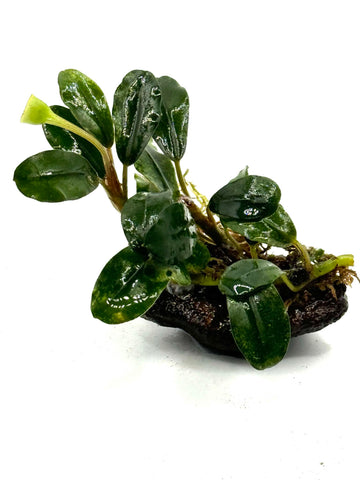Discovering Bucephalandra: The Exotic Aquascaping Star
Aquascaping enthusiasts are constantly on the lookout for unique and beautiful plants to enhance their Freshwater Aquariums. One such gem that has been gaining popularity in the aquarium community is Bucephalandra. In this comprehensive blog post, we'll explore what Bucephalandra is, its different variants, its suitability for beginners, and provide essential care tips to help you thrive in the aquascaping world.
1. What is Bucephalandra?
Bucephalandra, often referred to as "Buce," is a charming aquatic plant native to the islands of Borneo. This plant is found clinging to rocks and banks in fast-flowing streams and rivers, showcasing its ability to thrive under varying water conditions. Bucephalandra belongs to the Araceae family, closely related to more well-known aquarium plants like Anubias and Cryptocoryne.
The appeal of Bucephalandra lies in its lush, often colorful leaves and its hardy nature, making it a favorite among both novice and experienced aquarists. Its slow growth rate and ability to adapt to a range of light conditions make it an ideal candidate for various aquascaping projects, including low-light tanks and intricate underwater landscapes.
2. What are the Different Variants of Bucephalandra?
Bucephalandra comes in an impressive array of variants, each boasting unique characteristics in terms of leaf shape, color, and size. Some popular variants include:
- Bucephalandra Green Wavy: Known for its bright green, wavy leaves, perfect for adding texture to your aquarium.
- Bucephalandra Red: Features stunning red or pink hues that intensify under optimal lighting conditions.
- Bucephalandra Blue: Distinguished by its bluish or metallic sheen on the leaves.
- Bucephalandra Kedagang: Recognizable for its small size and dark, hammered leaves, making it a collector's choice.
Each variant adds a different aesthetic element to an aquarium, allowing aquarists to customize their setups based on visual preferences and tank conditions.
3. Is Bucephalandra a Good Plant for Beginners?
Yes, Bucephalandra is an excellent choice for beginners in the world of aquascaping. Its hardiness and low maintenance requirements make it forgiving for those new to maintaining aquarium plants. Bucephalandra's tolerance for a range of water parameters means it can adapt to less than ideal conditions, which is common in beginner aquarium setups.

4. How to Care for Bucephalandra
To ensure your Bucephalandra thrives, consider the following care tips:
- Lighting: Buce can grow in low to medium light. However, more intense lighting can enhance leaf coloration and growth rate.
- Water Conditions: Aim for a pH between 6.0 and 7.5 with moderate water hardness. Stable water conditions are preferable, although Bucephalandra can tolerate slight fluctuations.
- Substrate and Attachment: Similar to Anubias, Bucephalandra should not be buried in the substrate. Instead, attach it to rocks or driftwood using fishing line, cotton thread, or glue.
- Fertilization: While not a heavy feeder, Bucephalandra benefits from regular dosing of liquid fertilizers and occasional root tabs if attached near or on the substrate.
- Pruning and Propagation: This plant is easy to propagate; simply cut the rhizome and replant the cuttings. Pruning is rarely needed but can be done to shape the plant or manage its size.

In conclusion, Bucephalandra is not only a visually stunning addition to any aquarium but also a resilient and easy-to-care-for plant that suits both beginners and seasoned aquarists. Whether you're looking to add a splash of color or create a serene underwater landscape, Bucephalandra offers versatility and beauty that can elevate any aquascaping project. Dive into the world of Bucephalandra and watch your aquarium transform with these captivating plants!
